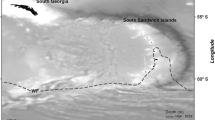Abstract
The age and habitat of the giant squid, Architeuthis sanctipauli Velain, 1877, were determined based on isotopic analyses of the statoliths of three female specimens captured off Tasmania, Australia, between January and March 1996. Assuming that the aragonite of the statoliths formed in equilibrium with seawater, δ18O analyses indicated that the squid lived at temperatures of 10.5–12.9°C, corresponding to average depths of 125–250 m and maximum depths of 500 m. The capture records indicated that these squid may have occasionally ranged still deeper, to as much as 1000 m. All the statoliths were labeled with bomb 14C (Δ14C=+22.9‰ to +44.6‰), consistent with the depths inferred from δ18O. A thin section through one of the statoliths revealed 351 growth increments grouped into check-ring structures every 10–16 increments. A model for statolith growth and the pattern of temporal change in Δ14C in the water column was used to estimate the ages of the three specimens. These estimates were very sensitive to the choice of depth range over which Δ14C values were integrated. Assuming that the capture depths represented the maximum habitat depths of these individuals, the calculations suggested an age of 14 years or less. More refined age estimates require a better understanding of the variation of Δ14C and temperature with depth in the areas in which the squids live.




Similar content being viewed by others
References
Arkhipkin AI (1997) Age and growth of the mesopelagic squid Ancistrocheirus lesueurii (Oegopsida: Ancistrocheiridae) from the central-east Atlantic based on statolith microstructure. Mar Biol 129:103–111
Bigg GR, Rohling EJ (2000) An oxygen isotope data set for marine water. J Geophys Res 105:8527–8535
Broecker WS, Peng TH (1982) Tracers in the sea. Eldigio Press, Lamont Doherty Geological Observatory, Palisades, N.Y., USA
Brunetti NE, Elena B Rossi GR, Sakai M, Pineda SE, Ivanovic ML (1998) Description of an Architeuthis from Argentine waters. In: Payne AIL, Lipinski MR, Clark MR, Roeleveld MAC (eds) Cephalopod biodiversity ecology and evolution. S Afr J Mar Sci 20:355–362
Druffel ERM, Griffin S (1995) Regional variability of surface ocean radiocarbon from southern Great Barrier Reef corals. In: Cook GT, Harkness DD, Miller BF, Scott EM (eds) Proc 15th Int 14C Conf. Radiocarbon 37:517–524
Förch EC (1998) The marine fauna of New Zealand: Cephalopoda: Oegopsida: Architeuthidae (giant squid). NIWA Biodiversity Mem 110:1–113
Forsythe JW, Van Heukelem WF (1987) Growth. In: Boyle PK (ed) Cephalopod life cycles, vol 2. Academic, London
Gardiner-Garden RS, Evans S, Middleton JF, Craig P (1991) A description of oceanographic data from Bass Strait, Jan–May 1991. University of New South Wales, Kensington, Australia
Gauldie RW, West IF, Förch EC (1994) Statocyst, statolith, and age estimation of the giant squid Architeuthis kirki. Veliger 37:93–109
Grossman EL, Ku T-L (1986) Oxygen and carbon isotope fractionation in biogenic aragonite: temperature effects. Chem Geol 59:59–74
Jackson GD (1994) Application and further potential of statolith increment analysis in squids and sepioids. Can J Fish Aquat Sci 51:2612–2625
Jackson GD, Lu CC, Dunning M (1991) Growth rings within the statolith microstructure of the giant squid Architeuthis. Veliger 34:331–334
Kalish JM (1991a) 13C and 18O isotopic disequilibrium in fish otoliths: metabolic and kinectic effects. Mar Ecol Prog Ser 75:191–203
Kalish JM (1991b) Oxygen and carbon isotopes in the otoliths of wild and laboratory-reared Australian salmon (Arripis trutta). Mar Biol 110:37–47
Landman NH, Ellis R (1998) Architeuthis—at last. Curator 41:150–152
Landman NH, Druffel ERM, Cochran JK, Donahue DJ, Jull AJT (1988) Bomb-produced radiocarbon in the shell of the chambered nautilus: rate of growth and age at maturity. Earth Planet Sci Lett 89:28–34
Landman NH, Cochran JK, Rye DM, Tanabe K, Arnold JM (1994) Early life history of Nautilus: evidence from isotopic analyses of aquarium-reared specimens. Paleobiology 20:40–51
Lipinski MR (1993) The deposition of statoliths: a working hypothesis. In: Okutani T, O’Dor RK, Kubodera TT (eds) Recent advances in fisheries biology. Tokai University Press, Tokyo, pp 241–262
Lipinski MR (1997) Morphology of giant squid Architeuthis statoliths. S Afr J Mar Sci 18:299–303
Lordan C, Collins MA, Perales-Raya C (1998) Observations on morphology, age and diet of three Architeuthis caught off the west coast of Ireland in 1995. J Mar Biol Assoc UK 78:903–917
Norman MD, Lu CC (1997) Sex in giant squid. Nature 389:683–684
O’Neil JR, Clayton RN, Mayeda K (1969) Oxygen isotope fractionation in divalent metal carbonates. J Chem Phys 51:5547–5558
Roeleveld MAC, Lipinski MR (1991) The giant squid Architeuthis in southern African waters. J Zool (Lond) 224:431–477
Roper CFE (1998) Tracking the giant squid: mythology and science meet beneath the sea. Wings 21:12–17
Stuiver M, Polach HA (1977) Discussion: reporting of 14C data. Radiocarbon 19:355–363
Tanaka N, Monaghan MC, Rye DM (1986) Contribution of metabolic carbon to mollusc and barnacle shell carbonate. Nature 320:520–523
Thorrold SR, Campana SE, Jones CM, Swart PK (1997) Factors determining δ13C and δ18O fractionation in aragonitic otoliths of marine fish. Geochim Cosmochim Acta 61:2909–2919
Urey HC (1947) The thermodynamic properties of isotopic substances. J Chem Soc 1947:562–581
Williams R, Mantyla A, Sanborn KM, Wylie JG (1976) GEOSECS Pacific Expedition: sections and profiles, vol 4. National Science Foundation, Washington, D.C., USA
Wood JB, O’Dor RK (2000) Do larger cephalopods live longer? Effects of temperature and phylogeny on interspecific comparisons of age and size at maturity. Mar Biol 136:91–99
Zeidler W, Gowlett-Holmes KL (1996) A specimen of giant squid, Architeuthis sp. from South Australian waters. Rec S Aust Mus 29:85–91
Acknowledgements
WOCE data for station P16A-10 were provided by Dr. E. Druffel, University of California, Irvine. WOCE data from the Indian Ocean stations were provided by Dr. B. Tilbrook, CSIRO Marine Research, Australia. We thank S. O’Shea (Auckland University of Technology, New Zealand) for helpful comments on an earlier version of this manuscript.
Author information
Authors and Affiliations
Corresponding author
Additional information
Communicated by J.P. Grassle, New Brunswick
Rights and permissions
About this article
Cite this article
Landman, N.H., Cochran, J.K., Cerrato, R. et al. Habitat and age of the giant squid (Architeuthis sanctipauli) inferred from isotopic analyses. Marine Biology 144, 685–691 (2004). https://doi.org/10.1007/s00227-003-1245-y
Received:
Accepted:
Published:
Issue Date:
DOI: https://doi.org/10.1007/s00227-003-1245-y




